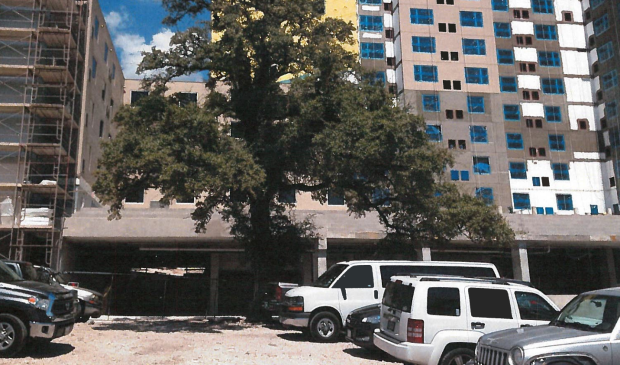Environmental Board sides with trees over variance
Tuesday, October 27, 2015 by
Tyler Whitson The future of two live oak trees in a downtown Austin parking lot sparked vigorous debate at a Wednesday meeting of the Environmental Commission, which ultimately recommended against the city granting a variance to its Heritage Tree Ordinance to make room for a proposed hotel.
Dave Anderson, an attorney engineer with the Drenner Group representing real estate investment firm Barton Creek Capital, told the Austin Monitor on Monday that his client has not decided whether to push forward with the project by requesting the variance from the Planning Commission and has requested postponement for today’s hearing of the item at that commission.
“We’re still in the process of figuring that out, still seeing if there’s a way that we could make the project work,” Anderson said on Friday. “The developer is still trying to figure out what they can do and what they can’t do.”
The property, which is zoned Downtown Mixed Use (DMU), is located at the northeast corner of Neches and Eighth streets and is home to a 32-inch live oak on the north side and a 30.5-inch live oak on the south side. It is also the proposed home of a 10-story hotel.
Staff recommended granting the variance for both trees at 150 percent mitigation, which would require planting trees sized at the equivalent of one-and-a-half times the trunk width of each of the removed trees.
“The subject trees have not received care, and the root systems have been compromised for likely decades,” reads the staff recommendation. “The trees are not of sufficient structural or biological condition to warrant preservation or transplanting as (they are) unlikely to survive code compliant construction impacts due to the already compromised rooting conditions.”
Anderson said that, if granted the variance, his client would mitigate removal of the 30.5-inch tree by paying into a downtown urban canopy preservation fund an amount equal to 150 percent mitigation. In addition, the firm would use the tree removal permit for the 32-inch tree only if it fails in an attempt to transplant the tree to a new location within three blocks of the property.
After failure of a motion from Commissioner Richard Grayum to recommend the variance only for the 30.5-inch tree with a 300 percent mitigation requirement, the commission voted 7-3 in favor of Vice Chair Marisa Perales’ motion to recommend denial of the variance altogether. Commissioners Grayum, Andrew Creel and Michael Moya voted against the motion, and Commissioner Hank Smith was absent.
“The applicant has not satisfied the prerequisites required under the Heritage Tree Ordinance,” said Perales. “In particular, the applicant has not shown that removal of the tree is not based on the condition caused by the method chosen by the applicant to develop the property.”
Perales added that part of the rationale for the denial is that both trees should be transplanted.
The city’s Land Development Code states that a land-use
commission, in this case the Planning Commission, may grant removal of a heritage tree as long as it is “not based on a condition caused by the method chosen by the applicant to develop the property” – unless removing the tree would allow for a design that protects other trees on site.
Keith Mars, environmental coordinator for the Development Services Department, explained why staff came to its conclusion. “What we have seen is that trees in this condition do not survive construction and, in particular, large-scale, commercial, steel construction,” he said.
Moya, who voted in favor of granting the variance for one tree, called that proposal a “win-win” solution. “These trees are not of great health,” he said. “There’s no requirements for anybody or the current property owner to go out there and care for them and improve their health.” He argued that mitigation and a potential transplant are a better alternative.
Zoila Vega and Michael Fossum of the Austin Heritage Tree Foundation testified against granting the variance in total, stating that they had hired a certified arborist who determined that the trees are not in poor health.
Barton Creek Capital, on the other hand, wrote in a memo to the commission that it had hired certified arborist Austin Tree Specialists, which recommended removing both trees based on health and other concerns.
Anderson said that, if granted the variance, the firm would design the hotel in a way that would not harm a heritage tree on an adjacent property, which is also part of staff’s recommendation.
The Heritage Tree Ordinance protects trees of certain species, including live oak, that are at least 24 inches in diameter.
Photo of the site at the northeast corner of Neches Street and Eighth Street courtesy of the city of Austin.
This story has been corrected. Dave Anderson is an engineer with the Drenner Group, not an attorney. In addition, the “Environmental Board” is now known as the Environmental Commission.
You're a community leader
And we’re honored you look to us for serious, in-depth news. You know a strong community needs local and dedicated watchdog reporting. We’re here for you and that won’t change. Now will you take the powerful next step and support our nonprofit news organization?








